- What is Amazon Marketing Cloud?
- Who can use the Amazon Marketing Cloud?
- How do I register for the Amazon Marketing Cloud?
- How does the Amazon Marketing Cloud work?
- What data is included in AMC?
- Features of Amazon Marketing Cloud
- Advantages of Amazon Marketing Cloud
- Conclusion
- FAQ - Amazon Marketing Cloud
Amazon Advertising is growing fast and becoming more diverse. In the meantime, Amazon is increasingly competing with Google and Facebook. This is because Amazon has many data about customer behavior. Sellers and vendors can place ads in Amazon Product Search (Sponsored Products, Sponsored Brands, Sponsored Display) or you can place bids for ad space on other websites with Amazon DSP (Demand Side Platform).
Amazon Marketing Cloud allows you to analyze the effectiveness of your advertising efforts across campaigns and channels. The analysis tool provides you with insights to optimize the performance of campaigns, for example. You learn which combination of media generates the highest sales for the target group via corresponding evaluations. In addition, you understand how campaigns affect the marketing funnel. The marketing funnel describes the most critical points of the customer journey, from seeing the product for the first time to making the purchase. This knowledge will help you plan, measure, and optimize advertising investments.
This article explains how to use Amazon Marketing Cloud and what benefits it can offer you.
What is Amazon Marketing Cloud?
Amazon Marketing Cloud is a reporting and analytics tool based on the Amazon Web Services (AWS) cloud platform. With the help of Amazon Marketing Cloud, you can access different customer behavior data. You get access to a database to which you can make further queries. The database contains various metrics about your campaigns. Thus, it is a so-called query-based system. You enter SQL queries into the database, and Amazon returns the requested values. You are provided an interface (API) to integrate the data into your database.
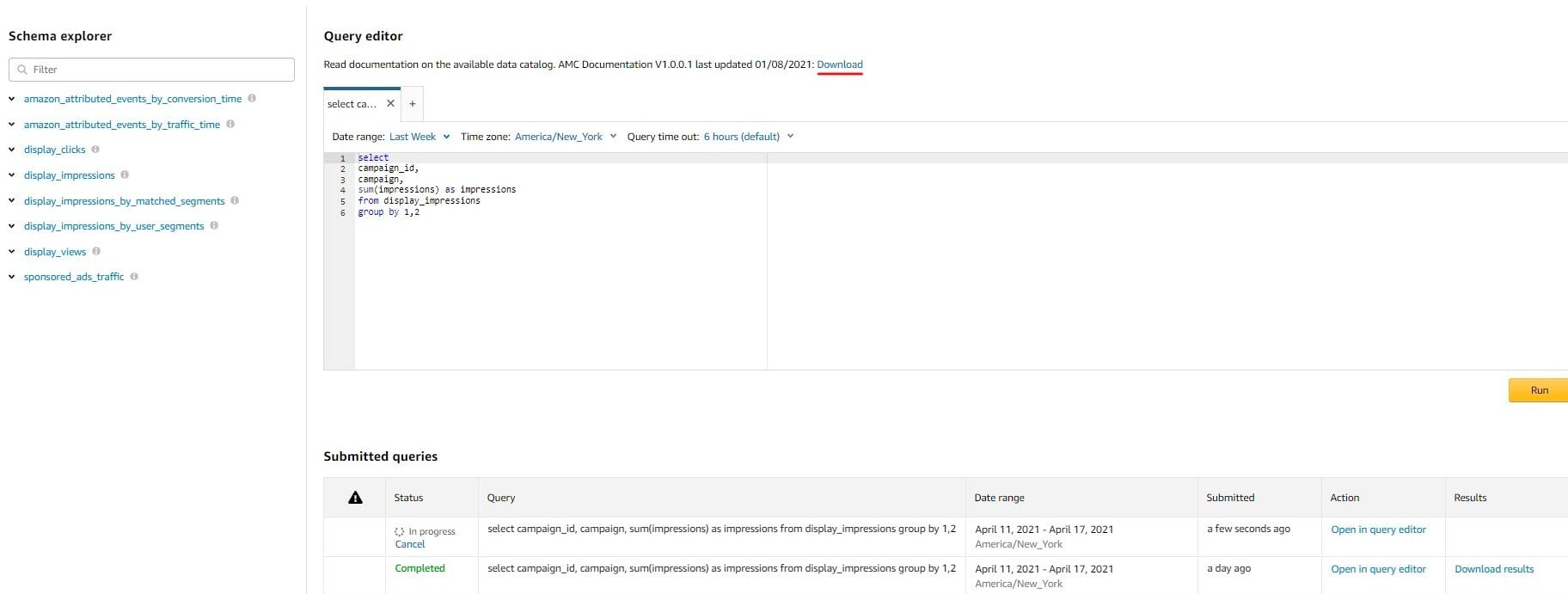
With Amazon Marketing Cloud, you can perform different analyses of the data sets to get aggregated reports. Over 1,000 metrics are queryable.
Examples:
- How many products were sold in the last x days based on the ad?
- How many users have interacted with the ad?
- At what times do most purchases and ad clicks take place?
- Which products generate a particularly high number of new customers?
With knowledge, you can accurately evaluate DSP and PPC campaigns:
- You understand which impact a campaign achieves at which point of the marketing funnel
- You can see the reach of your campaign
- You can identify the most effective sequence of your ads by looking at the customer journey
- You see the effectiveness and interaction of different media channels. You see which channels are preferred by which target group, how often they are used, and which actions are carried out on the channels
The Amazon Marketing Cloud also offers paid features for more advanced targeting options. These include "Amazon Shopping Insights", which are explained further down in the article.
Who can use the Amazon Marketing Cloud?
The Amazon Marketing Cloud is an independent interface that can be accessed via the Amazon API. Access to the Amazon Marketing Cloud must be set up by Amazon and is therefore not automatically available to every advertiser.
Requirements to use AMC:
- Your company must be an Amazon Ads Advertiser.
- You need a signed Amazon DSP MSA (Master Service Agreement).
- You are planning campaigns or have data on campaigns that have been live on Amazon DSP (Demand Side Platform) in the last 28 days.
- You need someone who has knowledge of SQL. SQL (Structured Query Language) is a database language that you can use to make queries to databases. Otherwise, you can also use "instructional queries". This is a collection of predefined SQL queries that can be used and adapted by AMC users for typical reporting and analysis purposes. Further information on this can be found further down in the article.
Marketing Cloud is available in Europe as of December 2023 on the marketplaces in Germany, Spain, France, Italy, the Netherlands, Sweden, Turkey and the UK. It is useful for merchants who invest in Amazon DSP and Sponsored Ads (Sponsored Products, Sponsored Display, Sponsored Brands).
How do I register for the Amazon Marketing Cloud?
Click here → to enter the Amazon Ads console and start registering. First, Amazon asks you to select the country where you want to advertise. Then you will fill out a contact form:

Once submitted, an account manager from the AMC team will contact you to create and set up the Marketing Cloud for you. The typical turnaround time is three to five days.
How does the Amazon Marketing Cloud work?
The Amazon Marketing Cloud works with instances. An instance contains the data of one advertiser at a time. You can use one or more IDs within the Advertising Console. You use multiple IDs, for example, to distinguish different business units or brands from each other. One advantage of AMC is that even if you have different advertiser IDs, you can still evaluate your data bundled in one AMC instance.
Initially, you view advertising data for the previous 28 days in the AMC console. Subsequently, the data is retained for a duration of up to one year, allowing ongoing access.
You use SQL queries to search the database for specific information. You can make various queries to get the data from Amazon Marketing Cloud. If you are familiar with SQL queries, you can write the queries yourself or otherwise use the instructional queries.
Instructional queries
To make an SQL query, you can use instructional queries. This is a collection of queries that can be used and customized. These queries cover common measurement and analysis cases and are provided with instructions for use and notes on interpreting the results.
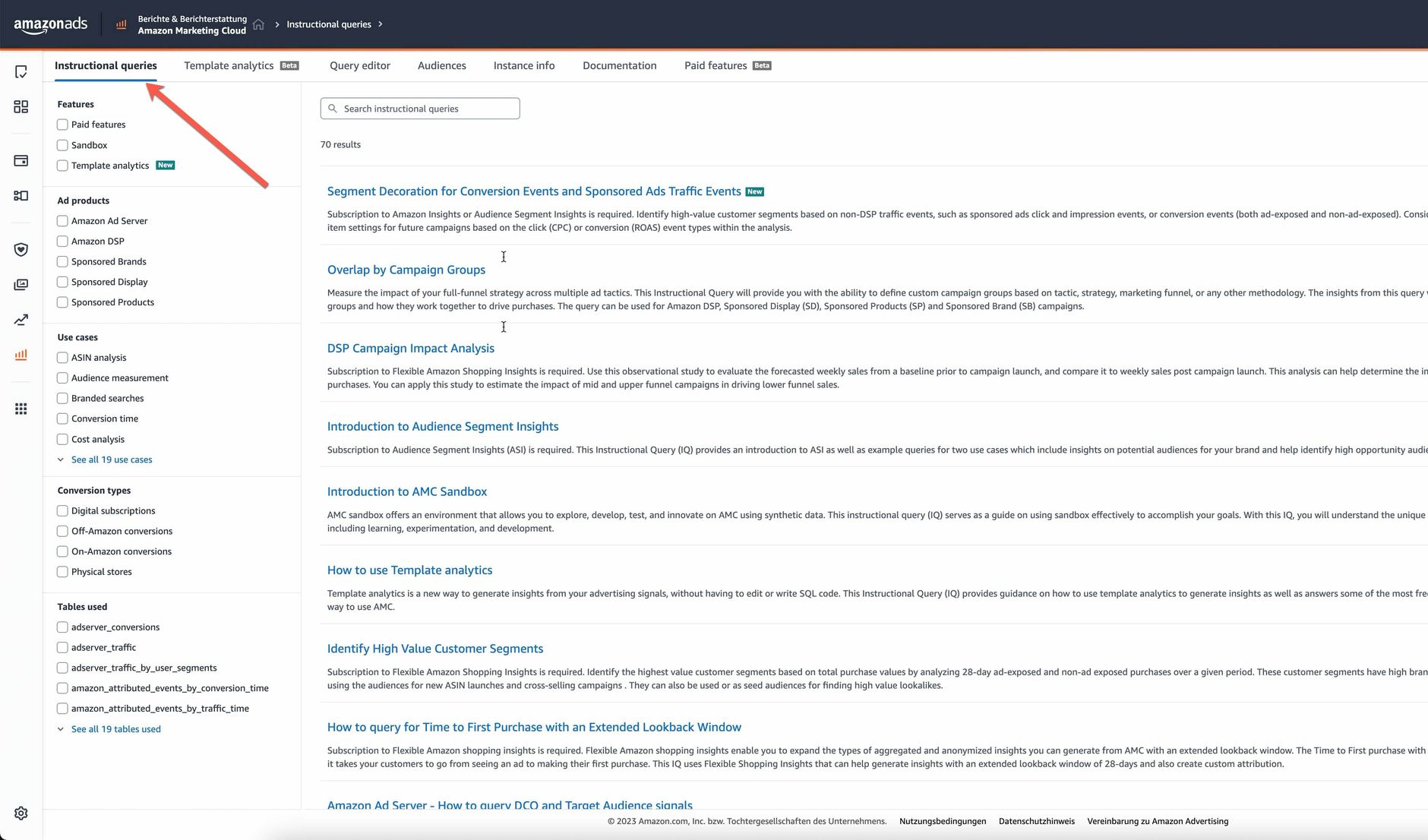
Here are some relevant instructional queries with instructions on how to use them.
New-to-brand gateway ASINs
This query helps to identify the most important ASINs that contribute to acquiring new customers (new-to-brand, NTB). NTBs are customers who have purchased the brand's products on Amazon for the first time within the last 365 days.
The query shows the advertiser name, ASIN number, total number of customers, number of NTB customers, percentage of NTB customers and the ASIN ranking based on the number of NTB customers for each advertiser.
SELECT
advertiser,
tracked_asin,
user_id,
(IF(new_to_brand = TRUE, 1, 0)) AS ntb_users
FROM
amazon_attributed_events_by_conversion_time
WHERE
purchases > 0 -- OPTIONAL UPDATE: uncomment and add the advertiser name
-- AND advertiser similar to 'xxxxxx'
-- OPTIONAL UPDATE: uncomment and add the campaign name
-- AND campaign in('campaign_name1', 'campaign_name2')
AND advertiser IS NOT NULL
GROUP BY
advertiser,
tracked_asin,
user_id,
new_to_brand,
asin_ranks AS (
SELECT
advertiser,
tracked_asin,
COUNT(DISTINCT user_id) AS all_users_with_purchase,
SUM(ntb_users) AS ntb_users,
SUM(ntb_users) / COUNT(DISTINCT user_id) * 100 AS ntb_percentage
FROM
users
GROUP BY
advertiser,
tracked_asin
)
SELECT
advertiser,
tracked_asin,
all_users_with_purchase,
ntb_users,
ntb_percentage,
RANK() OVER (
PARTITION BY advertiser
ORDER BY
-- OPTIONAL UPDATE: if you want to rank by ntb_percentage instead of ntb_users, change ntb_users to ntb_percentage.
ntb_users DESC
) AS gateway_asin_rank
FROM
asin_ranks
The query analyzes data on Amazon purchases to identify products that attract new customers for brands.
Common Table Expressions (CTEs):
- users CTE: Creates a table with information about advertisers, ASINs, and users who have made purchases. Identifies whether a user is new to the brand.
- asin_ranks CTE: Calculates the number of users, NTB users and percentage of NTB users for each advertiser and ASIN. Final Select Statement:
- Selects final columns, including advertiser, ASIN, total number of users with purchases, number of NTB users, and NTB percentage.
- Calculates a rank for each ASIN within each advertiser based on the number of NTB users. This helps to identify effective ASINs that attract new users.
In simple terms, the query ranks products by looking at how many new customers they attract to a brand.
Time to Conversion
The time-to-conversion query helps to find out how much time passes after a customer clicks on an ad before they actually buy the product. This information can be used to adjust the duration of campaigns and promotions in order to maximize sales. The query provides the purchase volume for each campaign and each advertiser, broken down by time to purchase.
Customer Value - Average Spending by Exposure Group
This query is used to calculate the total revenue that an advertiser can expect from a customer in a given period. This analysis helps to plan business and marketing goals. It is also interesting to compare the average revenue of a customer with ad contact and a customer without ad contact.
This query evaluates customer value through the analysis of total product sales among various buyers, examining customer behavior over a 60-day period in contrast to the standard attribution window. It compares the average spendings of customers who have been exposed to campaigns in the past 60 days with that of customers who have not been exposed to a campaign in the same period. To use this query, “Flexible Shopping Insights” must be added to your instance. To use this query advertisers need at least one campaign that ended 60+ days ago. The lookback period can be customized in the query as needed.
What data is included in AMC?
Since all customer information can only be handled according to Amazon's privacy policy, Amazon provides the data anonymously. Each buyer is assigned an anonymous and privacy-safe user ID. Every action is linked to a unique user ID.
Amazon Marketing Cloud only performs aggregated analytics to protect customer privacy. If only one customer performs a conversion, Amazon will show you that no conversion was performed because otherwise, you would be able to trace the customer. All aggregations must have at least 100 users. This ensures, on the one hand, that the reports are meaningful and, on the other hand, that the customer's privacy is protected.
Features of Amazon Marketing Cloud
As described earlier, Amazon Marketing Cloud lets you perform analytics across multiple data sets to create aggregated reports. With the help of the reports, you can take some actions to make your advertising efforts more efficient and targeted.
Understanding the target groups
One advantage of AMC is developing a better understanding of your target groups. You can analyze the buyers of your products and their (click and buy) behavior down to the smallest detail. For example, you can see what percentage of buyers are male or female, their age, income, or when customers are online or make a purchase. If more women buy your products, you should advertise more to women and consider this knowledge, for example, when designing the ad. If your customers are more likely to be online in the evening, you should adapt your campaigns to the time of day.
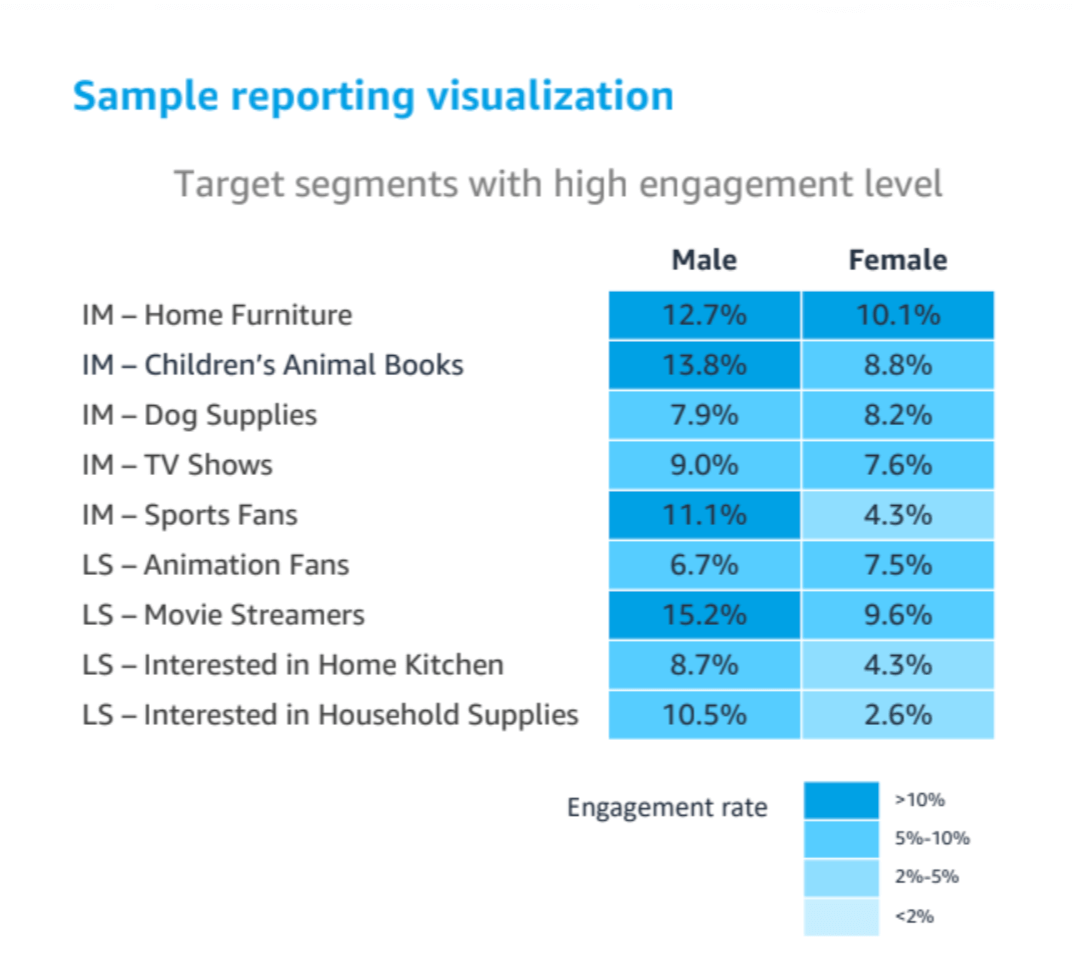
Likewise, you can see how many consumers have seen your ad in different phases of the marketing funnel. This will tell you which campaigns lead to brand awareness and which are crucial for purchasing.
You can leverage these insights by creating custom target audiences based on the identified behaviors and activate them for Amazon DSP campaigns using SQL queries. Additionally, you can set the frequency of audience updates to ensure that the created target audiences remain up-to-date.
Instead of addressing buyers solely based on their interests, you can engage them based on the ads or actions they have already seen or taken. Creating target audiences can be relevant for various scenarios, including:
- Potential buyers who clicked on a Sponsored Products ad but did not make a purchase → This audience may have a high purchase intent as they clicked on the ad. Targeted messaging to this group can lead to improved conversions.
- Potential buyers who added products to their cart but have not yet made a purchase → This indicates strong purchase intent. Remarketing efforts can result in higher conversions.
- Potential buyers who have seen an awareness campaign but not a conversion campaign → Conversion campaigns can help keep those who viewed the awareness campaign and achieve conversions.
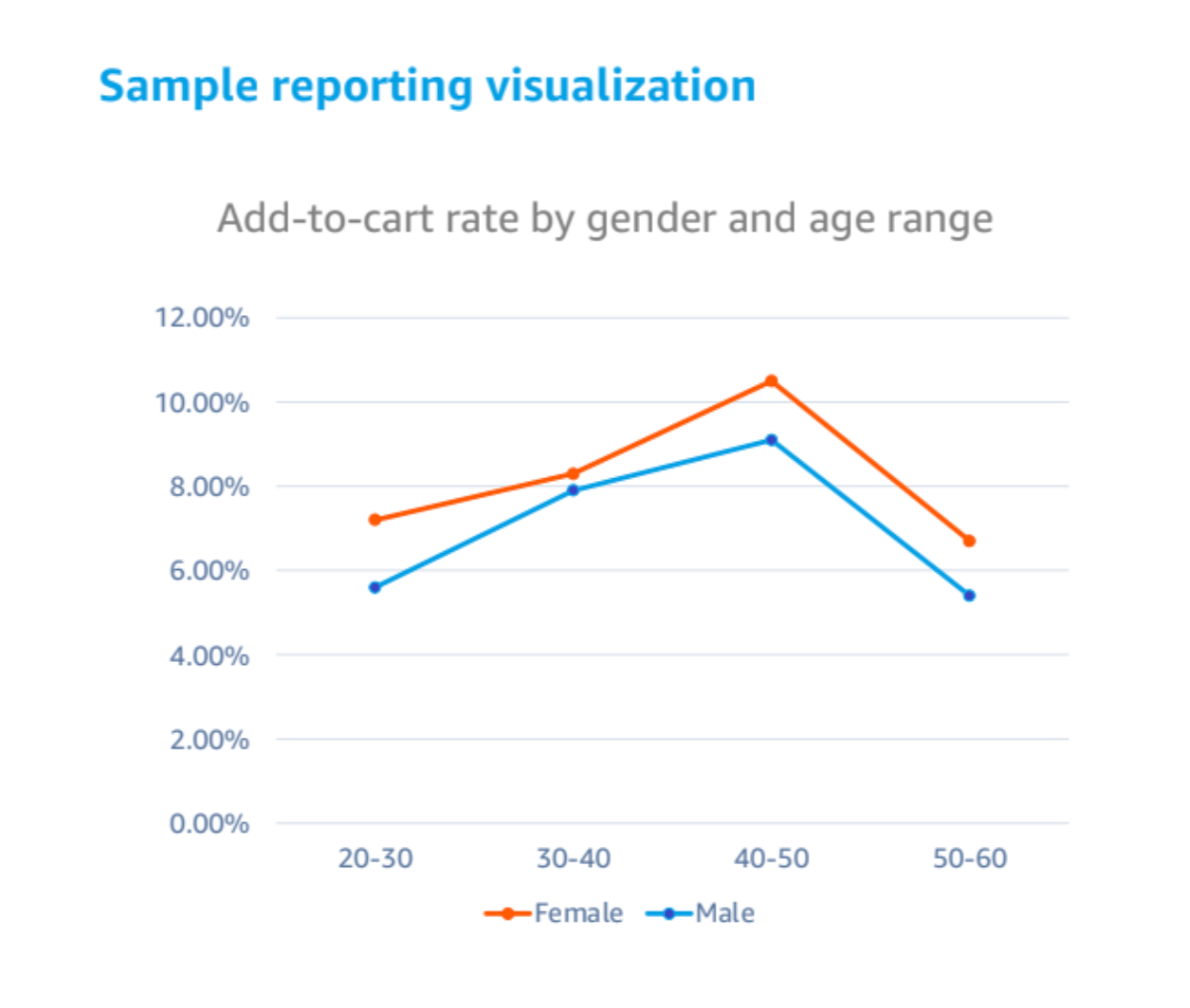
To create a target group, click on "Create Audiences". Then choose between the options "Create New Query" or "Create With Instructional Query". Custom target groups are also created using SQL queries.
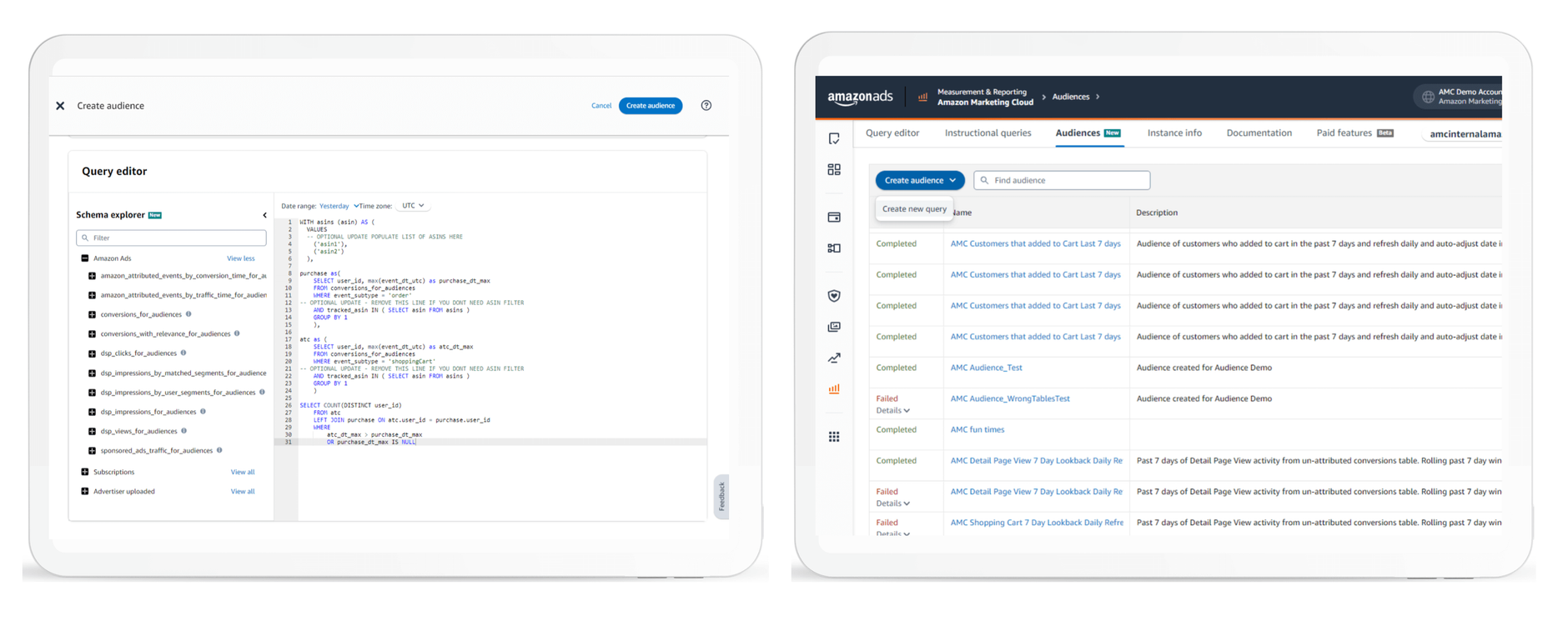
Newly created target groups in Amazon Marketing Cloud are visible under "AMC-user-defined name". Initially, the target groups have the status "Pending". As soon as they have been checked and confirmed, they switch to "Active" and can be used in your campaigns. Active AMC target groups can be found in the target group directory of your Amazon DSP instance under "Amazon > Custom-built". The performance of your AMC campaigns and target groups can be monitored via the reporting dashboards in Amazon DSP and AMC.
Development of new attribution models
Attribution models analyze a customer's touch points to conversion. For example, each attribution model assigns a value proposition to a marketing channel.
You can create new attribution models in the AMC console to see how different advertising investments contribute to conversions. For example, you can see how your investments in display or sponsored ad campaigns contribute to achieving your goals to optimize your campaign investments.
A key benefit of AMC is that you can measure the impact of advertising on your Amazon store and campaigns on your online store. You use Amazon's customer data to send customers to your website.
Leverage new reporting capabilities
Amazon Attribution lets you capture and evaluate the impact of your marketing campaigns outside of Amazon. The advantage of Marketing Cloud over Amazon Attribution is the flexibility of data retrieval.
The main advantage of Amazon Marketing Cloud is the quality of the reports and the comprehensive and detailed data you provide. The better informed you are about how customers become aware of your products, the more efficiently you can design your advertising measures. When customers see your ads before your competitors' ads, you stand out from the competition and stay one step ahead of them.
Integration with customer data platforms (CDP)
Since 2023, it has been possible to integrate Amazon Marketing Cloud and Amazon DSP data with customer data platforms of various providers, including Adobe, Lytics, Relay42 and other providers.
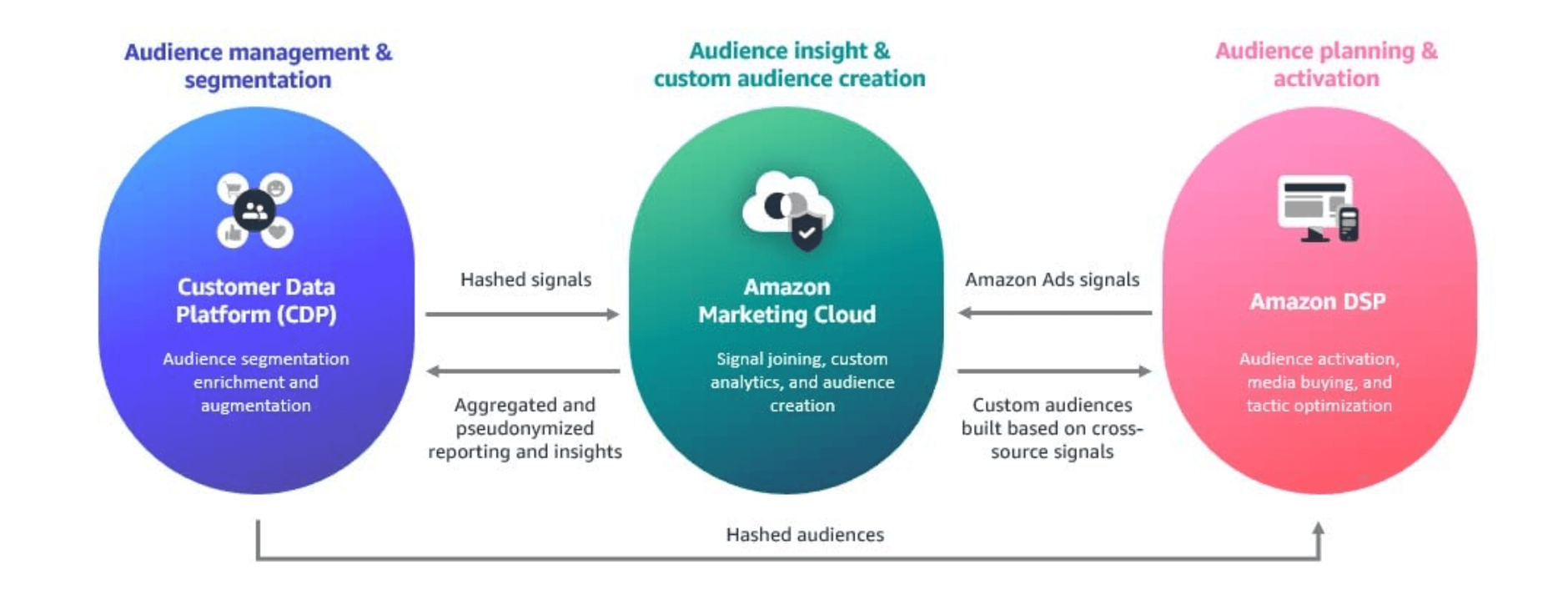
This integration provides brands with the opportunity to enhance their Amazon Ads efforts by directly transferring audience lists and signals into Amazon DSP, while conducting customized analyses for more comprehensive insights.
Simulation of AMC activities
The Amazon Marketing Cloud Sandbox is a feature that allows advertisers to simulate AMC activities affecting live AMC instances. This works because the data is not associated with any advertising campaign, customer identifier, or product. As a result, a secure environment is created, enabling users to replicate the functionality of AMC and work with synthetic signals to test various scenarios.
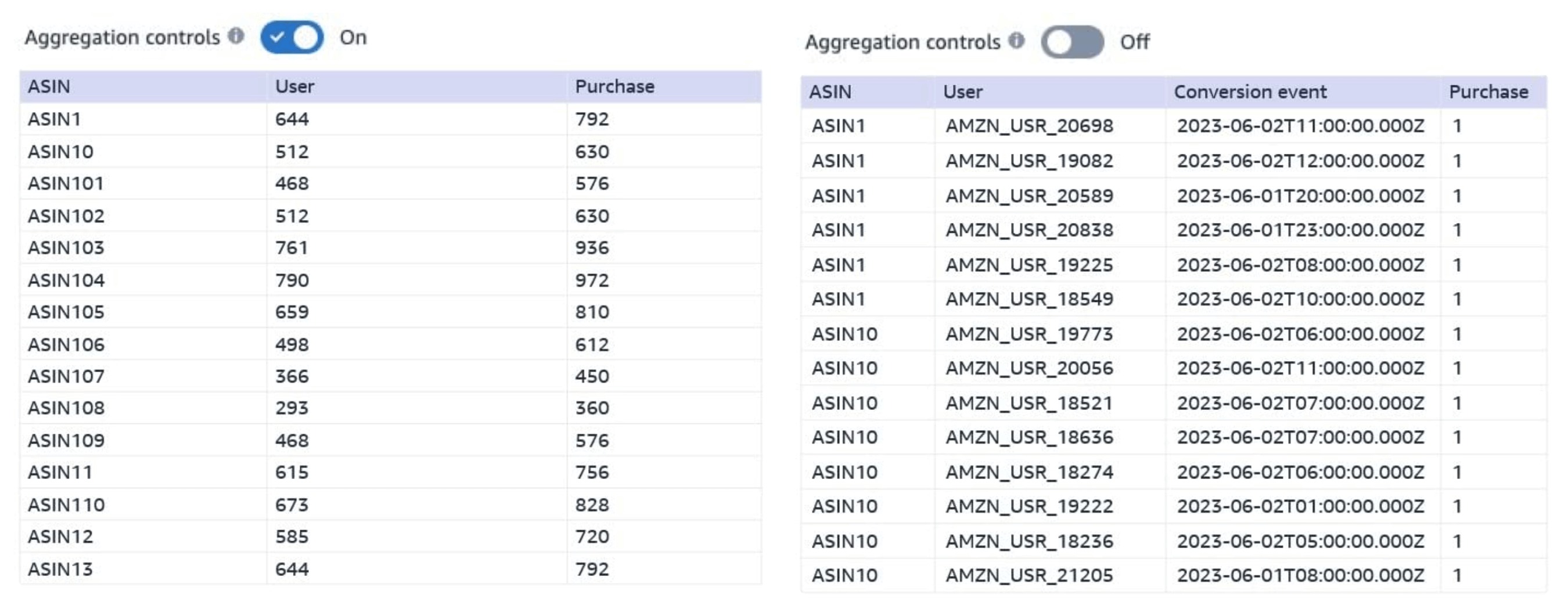
The AMC Sandbox offers features such as Aggregation Control and Table Preview. The Aggregation Control allows you to choose between a summarized overview and detailed insights at the event level. This is helpful depending on whether you want to make a general performance assessment or delve more deeply into individual events.
Amazon Insights Subscription
Users of the paid subscription "Amazon Insights" enjoy additional benefits. This includes the features "Amazon Shopping Insights" and "Amazon Audience Segment Insights". The monthly fee varies depending on the quantity of data and the size of the brand.
Amazon Shopping Insights is a paid feature that allows advertisers to expand their insights within the Amazon Marketing Cloud. The functionality is based on an additional data source in AMC. This source comprises trade data not resulting from interactions with Sponsored Ads or DSP campaigns. This allows for the comparison of shopping behaviors (number of visits, additions to the cart, revenue volume, etc.) between users exposed to advertising campaigns and those not exposed. As a result, you gain more precise insights into the effectiveness of your media campaigns.
In contrast to the free version, which provides an overview of campaigns for the past 28 days, Amazon Shopping Insights offers a comprehensive perspective over a time window of up to 12.5 months.
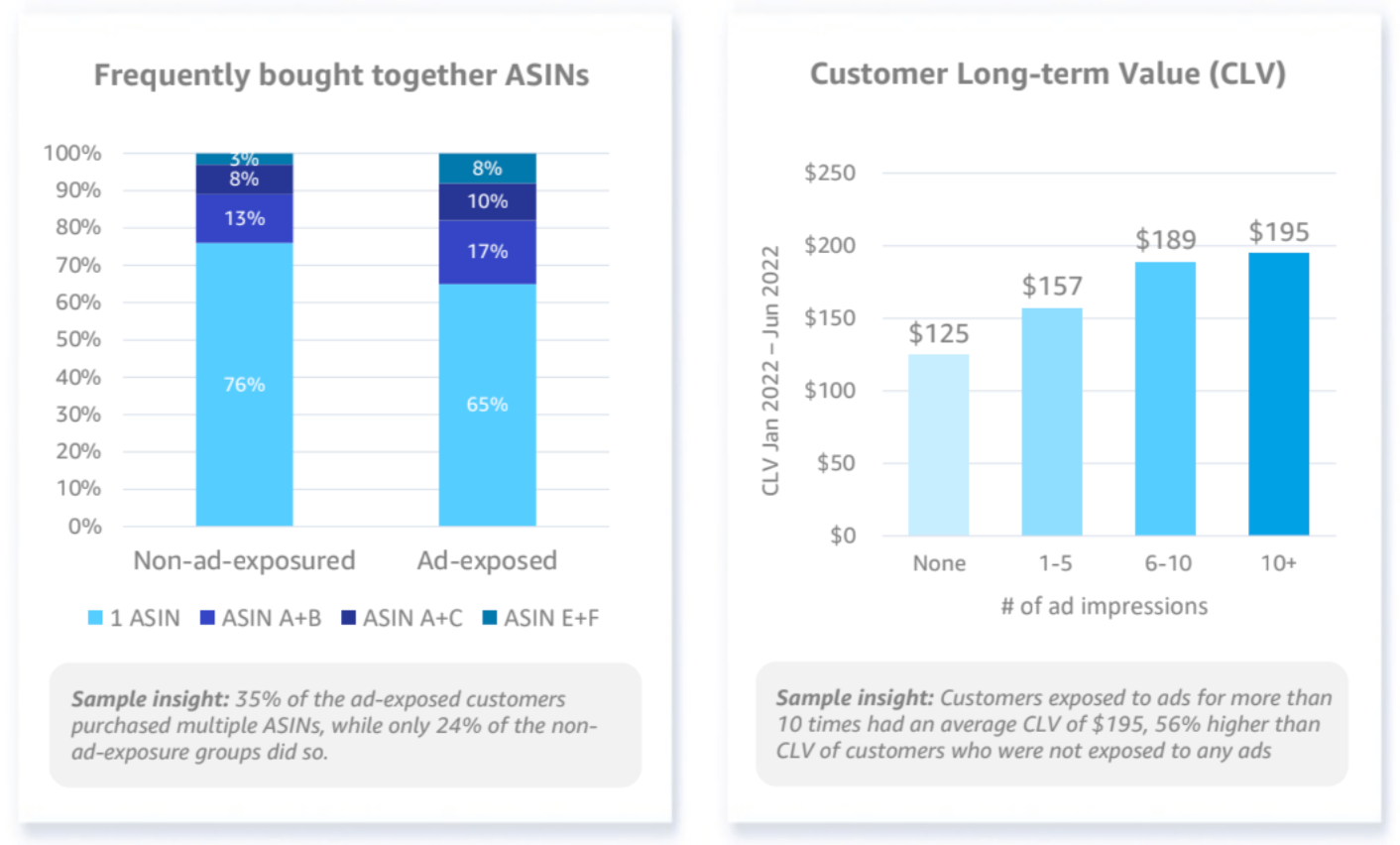
Amazon Shopping Insights enables various strategic approaches:
- Extension of Reach: Addressing relevant target audiences that have not been exposed to ads before allows identifying buyers who have not yet discovered your product.
- Cross-Sell / Up-Sell: Targeting audiences that have purchased a specific product (A) but not another product (B) provides the opportunity for cross-selling or up-selling strategies.
- Activation of Inactive Buyers: Target groups that have made purchases in the past but have not been active for some time. This makes it possible to target inactive customers or customers who have not been engaged for some time.
- New Customers: Targeting audiences that have recently become aware of your brand, regardless of whether they were previously exposed to ads or not, provides insights into acquiring new customers.
- Seasonal Buyers: Target groups that have made purchases in past promotions during a specific time period. This enables you to approach customers who have demonstrated a willingness to buy in previous promotions.
- Products in Cart: Targeting audiences that have added products to the cart but have not completed the purchase provides the opportunity to approach customers who have already shown interest but have not yet completed the purchase.
The "Amazon Audience Segment Insights" function also provides advertisers with detailed insights into customer behavior. The function allows both the analysis of overall user data and the segmentation of individual data. It provides real-time information and supports advertisers in planning, measuring and activating their campaigns. This allows the analysis of aggregated patterns, including, for example, how often advertised products are viewed before purchase. This is particularly advantageous for brands with products that have a longer sales cycle. Additionally, reports on the frequency of product purchases or the order of purchases can be generated.
Through analyses of "New-to-Brand" customers, purchasing patterns and target audiences, this feature enables a more targeted and effective alignment of advertising strategies. This gives you integrated insights into advertising and audience segments.
Companies have the option to use this feature in combination with other paid as well as free services offered by the Amazon Marketing Cloud.
Advantages of Amazon Marketing Cloud
The individual features of the Amazon Marketing Cloud offer several advantages for advertisers.
- Detailed Campaign Analysis: AMC enables in-depth analysis of advertising campaigns and their impact.
- Access to Reach and Frequency Data: Advertisers can retrieve data on reach and frequency of campaigns.
- Customizable Queries: Advertisers can customize queries according to their preferences.
- Customer Journey Analysis: AMC allows the analysis of different phases of the customer journey and evaluates how specific actions can contribute to sales.
- Linking of Search and Display: AMC contributes to understanding how search and display interact.
- Access to Cross-Platform Insights: Advertisers can gain cross-platform insights into various types of ads.
- Understanding Target Audiences: AMC enables the understanding of target audiences and the creation of detailed custom audiences based on data.
- Setting Signals Across Different Channels: AMC allows you to define signals for engagement and conversion across various channels.
- Complementing Amazon DSP Reports: AMC complements Amazon DSP reporting by providing cross-platform performance metrics. Thanks to its features, AMC enables advertisers to optimize their advertising strategies based on data for an effective, targeted customer approach.
Conclusion
With the help of Amazon Marketing Cloud, you can access various customer data. The advantage of Marketing Cloud is that you get data across all channels. Use the data to understand your customers' behavior better. Knowing when customers shop, how old customers are, or whether they are high- or low-spenders, you can target your advertising more effectively, optimizing your investment.
By combining advertising measures and encrypted data, the impact of specific campaigns, ad formats or audience targeting can be understood holistically. Amazon Marketing Cloud offers helpful features such as the creation of customized target groups or the use of new reporting options. Paid features also offer the opportunity to gain even deeper insights into customer behavior.
However, in addition to the benefits, users must also expect some limitations. The limited viewing period in the free version makes it difficult to make comparisons over a longer period of time.
FAQ - Amazon Marketing Cloud
What does Data Clean Room (DCR) mean?
The "Data Clean Room" structure in AMC ensures the anonymity of the analyzed customers by making personally identifiable information (PII) inaccessible.
What are SQL queries?
SQL (Structured Query Language) is a standardized language widely used in database management. SQL queries are statements written in a specialized programming language to access relational databases. These queries make it possible to perform various tasks with databases, including searching, inserting, updating and deleting data records.
Is AMC free of cost?
The use of AMC for advertising through DSP is free to use. However, if you want to access additional datasets, such as Amazon Shopping Insights, you need to subscribe. The price depends on the size of your brand and the quantity of used data.
What is the difference between an awareness campaign and a conversion campaign?
An awareness campaign aims to bring attention to your product or brand, typically achieved through advertisements designed to increase brand awareness. Once the target audience becomes familiar with your brand through the awareness campaign, conversion campaigns can then focus on moving individuals further down the sales funnel. Special offers or discounts may be utilized in conversion campaigns to intensify interest and encourage them to make an actual purchase.
More articles about marketing on Amazon that may interest you:





